No decent allotment should be without a rhubarb plant, and no allotment holder should ignore the charms of rhubarb wine. Not only does it make an alternative culinary use to crumble, but it’s one of the finest homemade wines there is. So I sterilized the kitchen, followed the easiest recipe going and began brewing.
The process started by chopping up 3lbs of rhubarb, bashing it up a bit with a rolling pin in a bucket, and adding 3lbs of sugar.
Tomorrow I’ll strain the juice into a demijohn, top it up with warm water, add a sachet of wine yeast and fit an airlock.
Once fermentation is complete it’ll get racked off into a clean demijohn where it may go on a secondary, slower fermentation. This process can then be repeated after a few weeks, but either way the wine should be ready in about six months.
+++++++
For more great recipes…
Rhubarb wine features in our debut book, Brew it Yourself, which is packed with booze making recipes and advice on how to grow or source many of the key ingredients. For the rhubarb fan it includes a delicious rhubarb and vanilla liqueur which we use in a rhubarb and custard cocktail. Available from most good book shops and on Amazon.
+++++++


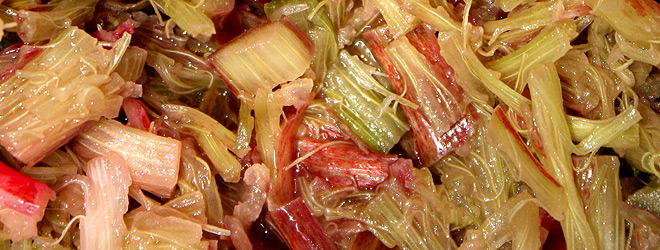
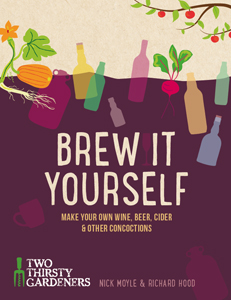
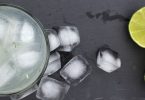
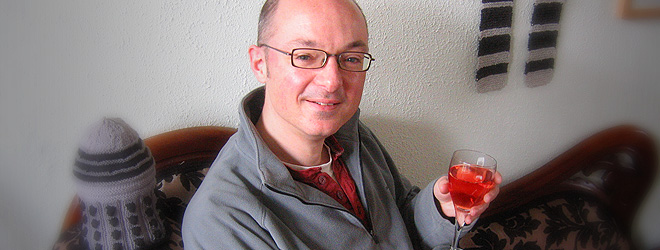
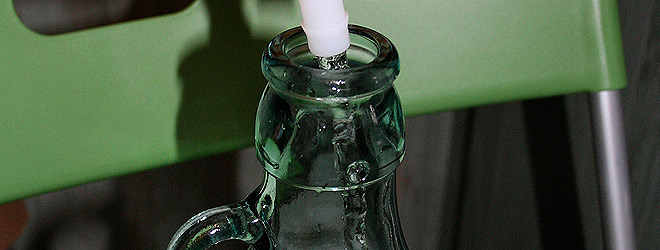
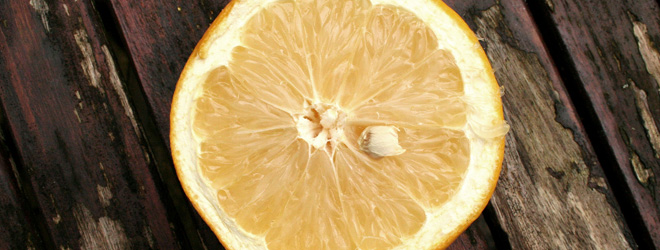
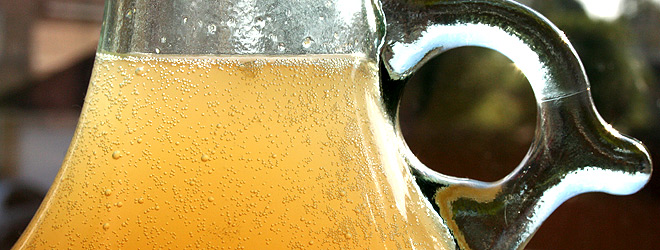
Had no idea this concept existed. I have rhubarb. I love wine. This has to be tried!
Let us know how you get on! And keep checking the site – more ideas of how to turn surplus veg into wine coming soon…
try adding 1/2 lb of crushed raisins but reduce the sugar a bit , makes it a bit more mellow and gives it ‘body’.
That’s a good tip, thanks. I added raisins to our elderflower wine for exactly that reason. I was quite keen to see how the rhubarb wine would taste at its most basic level – next year we can try some additions to see how it varies.
Nice simple recipe, mine is on my Blog http://allotment65.blogspot.co.uk/2012/08/super-sunday.html also adding raspberries but this year I added Blackcurrants, will Blog about its success or fail LoL
Thanks Ian. I like the sound of the black currant version. Keep us posted with the results and we might just try some with next year’s rhubarb harvest…
I have given up on this method of rhubarb wine. I kept on getting a swiss cheese taste – propionic acid? So now, I boil my rhubarb and add sugar to the liquid, rather than extract the liquid with sugar only. I don’t know if anyone else has the swiss cheese problem? It doesn’t go brilliantly with a wine taste. Otherwise rhubarb wine is excellent – and the best colour of any wine I do.
How curious… our rhubarb is very drinkable even at this early stage, and no cheesy notes at all. I have read that wine quality can vary from stalk to stalk. We used mid-season, mainly green stalks and have an almost colourless wine. I have a suspicion that the pinker, earlier cuts are less successful… but can’t verify that.
Hi, I use early rhubarb and so far have had no problems with the wine and its a lovely pinkish colour and very champagney, pop goes the cork. Never lasted the six months and it goes very well with a sweet course
Hi Bill
Many thanks for the feedback. We’re currently growing lots of different varieties of rhubarb, including some early varieties, to see which one makes the best wine. I also like serving it with a sweet course and have been known to sweeten it a touch in the bottle to give it a dessert wine quality.
Keep popping those corks!
I’m going to have a go at this today, methinks. I have none of my own rhubarb because, well, you know. But fortch the lady down the road is selling it by the massive bunch for 60p a pop!! My question is THIS: isn’t it a right faff putting all the extra bits straight into the demi john? Is there a reason you can’t strain the rhu-juice off into another bucket, stir it all up and then pop (ok, syphon) it into the demi john?? Or doesn’t it really matter? And have you ever tried making rhubarb beer a la ginger beer? Can’t really find any recipes for this so am presuming that it just doesn’t work. That was four questions. Sorry.
I guess you can strain it into another vessel. But the other ‘bits’ are only water and yeast… and by straining the juice directly into the demijohn first you know exactly how much water needs adding. And there’s less washing up.
There are hundreds of ways to make rhubarb wine – it’s not a precise science – and I’m sure you’ll love the results however you make it.
There are several recipes out there for rhubarb ‘champagne’ – which is essentially ginger beer with rhubarb instead. This year I will be attempting a rhubarb and elderflower ‘champagne’. Method TBC.
Yeah, when thought about it I realised it wasn’t really that faffy. I s’pose I was wondering more how the yeast gets mixed in properly, or doesn’t that matter? I’ve only got two pounds of rhubarb so it turns out. I’ve bashed it all up with two pounds of sugar but when it comes to putting it in the demi-john do I have to fill it right to the top or is it okay to leave space in it? Or would it be better to make up the rhubarb shortfall with something else (apples maybe)? I suppose I just don’t want it to be too wishy washy. Many thanks for your ongoing assistance in this matter and putting up with my stupid questions. PS will send updated pics of my spud fort soon
Right then… lets see if we can answer these questions
• Yeast. Always best to follow the instructions on the packet, but if that sounds like too much of a cop out then mix it in with a bit of warm water then pour that into the demijohn with the rest. Give it a wee stir. Make sure everything is sterilised, obviously.
• You should try to fill the demijohn. Air and wine don’t mix when fermentation subsides. And as you’ll also lose a bit of volume when you ‘rack off’ you’ll end up with a large shortfall. So, yes, top up to the neck. I reckon two pounds will give a fair rhubarb taste so maybe a juice and water mix plus another half pound of sugar? (I’m kinda guessing). Grape juice is usually the weapon of choice but failing that apple, raspberry, guava and lime… anything really should be fine. Alternatively you could turn it into a rhubarb and elderflower wine – follow our elderflower wine recipe using a third of the ingredients then add to the blend.
• Keep firing more questions our way. And update us with progress – it very much sounds like you’re inventing a new wine which is always exciting!
Ta Nick… I have just added 300g raisins, 200g apples, a bit of brown sugar and a lemon. I’ll leave it for another day and put it in the demi-john tomorrow.
Nicely done. Look forward to hearing about its progress.
Hi what does rack off mean!
Hi Carole
Transfer the liquid from one demijohn to another so you leave behind the mucky stuff at the bottom.
There should be a link within the piece to explain more – click on the words ‘racked off’.
Enjoy your rhubarb wine
nick
Love reading your tips.am confused by some sites and i am sure they omit a fair bit! as i am new to it i even had to google “racking” to know what to do.now have feijoa wine in carboys and today chopped the rhubarb.Your recipe does not mention pectin or campden…do you not use these?
ps. my feijoa has stopped bubbling finally but is quite cloudy. what cheap and easy remedy would you recommend?Thank you.
Hi. Thanks for visiting the site.
To answer your queries…
Campden: Yes, we do use tablets for most recipes but wanted to show that you can still make great wine without – many people have allergic reactions to sulphates, which is what they produce, so it should be treated as optional.
Pectin: This is a natural substance that can cause cause cloudy wine. It’s not a problem, apart from aesthetics. The best remedy is pectolase which is usually added at he beginning but can also work if added during racking. Again as its not an essential ingredient we wanted to show that you can make wine without it. You can also try egg-shells. More info here https://twothirstygardeners.co.uk/2012/09/cloudy_coloured_wine/
Racking: There’s a link to racking off within the article.
Feijoa: We’ve not tried feijoa wine before so please keep us posted with progress!
Many thank! Will try the eggshells.tastes beautiful so far.
the eggshells worked!
eggshells worked a treat and the wine is very clear.However, it is very sweet and I prefer a chardonnay to a sav blanc..soooo, would it help to add some yeast to the wine to break down the sugar?? also, the rhubarb is bubbling away and is almost shocking pink in colour,so very excited about that!
Hi Joy. Apologies but I’ve only just noticed this post…
How to make a wine less sweet? That’s a tricky one! Yeast dies when the alcohol level reaches a certain level… so it could be you had more sugar than the yeast could handle. In which case re-pitching is unlikely to help. Alternatively it could’ve stopped prematurely for any number of reasons, in which case re-pitching might help.
And there are also some sugars in some ingredients that don’t ever ferment out so always leave a touch of sweetness in the final beverage.
Sounding vague, huh?
If you do decide to put more yeast in then pick one that has been designed for high alcohol wines, or you can even get specialist re-start yeasts.
I never mind a drop of sweetness in home-made wines so haven’t any experience of your particular problem but maybe someone else reading this could help?
My wine is bubbling well but the level has gone down. Can I top up with water?
You can top up with water. Make sure it has been boiled first then cooled before adding, using sterlised equipment of course. And if you want to maintain the same alcohol strength you can add a touch of sugar, but this isn’t vital
Thank you . Water boiling sugar ready
Excuse me but being really green ,why the eggshells and what does it do? Clear the wine?? If so does it work on all wine and how or whats the science behind it.Thanks
The eggshell method is here: https://twothirstygardeners.co.uk/2012/09/cloudy_coloured_wine/
I haven’t delved fully into the science, other than it’s something to do with the coloured particles clinging to the calcium as the small bits of shell rise and fall. This helps clear a cloudy wine – by no means guaranteed but it certainly seems to help.
Hi there Nick,
My friend has made rhubarb wine before and it was delicious..! Today I am going to go and forage some rhubarb for wine. I was wanting to make rhubarb and ginger wine but I am having trouble finding a simple recipe with a specific quantity of ginger. I usually do 3lb fruit/flowers etc and 3lb sugar with yeast and yeast nutrient. So I was wondering if you had any tip or info on how much ginger I could put in..? Also many recipes call for sultanas but I was wondering if I could leave them out…?
I am a complete noob at wine making but have helped friends make wine before. To date I have made red clover wine and redcurrant wine. They are currently bubbling away beside my stove… Excited to try it soon…!
BTW great site..!
Many Thanks
Anna 🙂
Hi Anna
I’ve heard other people have success with rhubarb and ginger, but haven’t tried it myself. It can be quite overpowering so don’e get too carried away with it – a small, sliced nob of ginger should suffice (say around 50g). Sultanas are used to add a bit of ‘body’ to wines but I find rhubarb works perfectly well without this addition. Let us know how you get on, and would be interested to hear the results of your red clover wine and red currant wine – we’ve not made either.
Glad you enjoy the site.
nick
Would you happen to know how to brew rhubarb and apple together in about 3 months? I have rhubarb from my back garden and a bunch of apples from a friend’s. They have already been waiting patiently together in my freezer for months until I find a decent recipe.
I have done blueberry wine before, but can’t seem to find anything on combing rhubarb and apple.
I’ve never combined the two, but there’s absolutely no reason why you shouldn’t. I would suggest suggest replacing 1lb rhubarb with 2lb apples (or 1.5lb with 3lb; 2lb with 4lb; etc). Wash and chop the apples and simmer them in water until they start to soften. Then combine this liquid appley mix with the rhubarb juice and sugar using the method in this recipe. When cool add the yeast and ferment in the bucket for a few days. Then strain into a demijohn.
Let us know how you get on… if it works then you’ll have to write us a guest recipe for the website!
nick
I have never made non kit wines before bur have loads of rhubarb in garden.I have used egg shells to clear consomme’s (clear soups) and they work well in them so will try if needed in wine ..
Hi all
Have you got to be a member of this site, If so how does one join?
I’m just about to start on my homemade wine trip, still short of one or two things which I had years ago when I made Beer, like a heating belt, Hydrometer, thermometer (Gave them away), I in fact have three Demi-johns, two air locks, “Bruclens Cleaner & Steriliser, plus an never ending suply of optmisim. How many demi johns would be idea for the small mine maker?
Phil
hi 2TTGs, was pleased to find someone posting lovely and important things to do with the vegetable/ fruit stuff growing in ones plot, as i was looking for an easy rhubarb wine recipe.
Now admittedly i should have asked first but it became evident that your quantities were NOT for a demijohn the size of the one i inherited from the previous tennant (its a 5gallon one), so in haste i ran outside to cut more barb and had a few more kilos of sugar, but could only summon the strength to hack up 3kg worth of fruit (i must buy a kitchen knife). So when it came to toppng up with water i only filled to the 3gallon mark. Now i know you advised to fill ones demiohn to the top to exclude air so you might well tell me thats where it all went wrong.
But by the next day i could barely see any bubbles coming out of the airlock, or froth on the liquid (athough its a white container and not easy to see contents.)
My question is have i killed the yeast before it had time to work on the sugar? Could it have been too cold/ hot (i used half boiling half cold water)? or is it the air?
Should i dump this mess and leave it for the butterflies and start again with the right amounts of fruit sugar water to fill the 5G container? its been sitting a week now.
hope you can advise; ive promised mates there will be homemade wine by xmas….!
Hi Helen
Of all those things you mention the only one that would kill the yeast is a higher temperature than it likes.
My suggestion would be to give it a stir, add some more yeast and store it somewhere with a consistent temperature – not to hot, not too cool.
If that doesn’t start fermentation then I’ve no idea what’s going on!
And at some stage you should try to rack it into 3 x 1 gallon demijohns to keep the oxygen at bay.
Good luck!
I had less rhubarb this year so I added 3 mashed bananas. Also I used a “high alcohol dessert wine” yeast. This wine should be “interesting”.
[…] Link: https://twothirstygardeners.co.uk/2012/06/turning-rhubarb-into-wine/ […]
I had a large crop of rhubarb in in April and used your simple recipe. At the beginning of August it was ready for bottling. It is beautifull clear with a pale pink tinge and very dry and we ‘sampled’ a bottle (whole) yesterday. As I forgot to take any readings we have no idea of the finished ABV but hubby drank two glasses and retired to his bed to sleep it off.
Second batch is bubbling away.
We have promised to leave the rest until Christmas but should we leave it this long as I am uncertain about the keeping properties?
p.s.
first timer and hope that it is not beginners luck.
Hi Sandie. I’m sure it wasn’t beginners luck, but only one way to find out…
Good news on the keeping properties. Like all wines, homemade wines benefit from ageing in bottles. Red wines packed with tannins will rock on for years, gradually improving, while white wines with less tannin reach their peak a bit quicker (although we’re still talking several years). Exactly when they’re at their best varies from batch to batch and is largely a subjective thing, but I tend to enjoy rhubarb the most around 18 months to 2 years after making. So Christmas is well within range and, if you can keep your husband off it, I would try to save a bottle for the following Christmas to see how it measures up. Enjoy!
Hello there, just started my very first batch of rhubarb wine, and I used this post as one of my guiding milestones. Cheers for the info!
https://nox1990.wordpress.com/2015/05/14/homemade-rhubarb-wine/
Update on my wine!
https://publichousestories.wordpress.com/2015/06/18/rhubarb-wine-update-and-lighthouse-jackline-rhubarb-grisette/
The link on my first comment will expire in a couple of months, so here’s the updated version! The link of my second comment is unchanged.
https://publichousestories.wordpress.com/2015/05/14/homemade-rhubarb-wine/
Hi total novice here, got given a load of rhubarb so decided to give this a go chopped rhubarb and put in in container with the sugar – two days ago – getting a Demijohn tomorrow so I will need to sterilize this over night (hope the rhubarb doesn’t go mouldy) but I had no luck finding a demijohn sooner – my questions are – do I need to put demijohn in a warm place i.e.. airing cupboard, do I need two Demijohns as you state transferring wine from one to another before bottling up, and also what is a gravity reading – PS: I always rush into things, its utter madness but really wanted to try this
Hi Jenny
Welcome to the excitement of wine making!
To answer your questions…
Yes, a warm location such as an airing cupboard is ideal. I used to ferment all of my wines in the airing cupboard but got told off for making the clothes smell of yeast (but I had a lot of wines). Just make sure to put an old towel under the demijohn for the first few days – they have been known to bubble out of the airlock.
Two demijohns would be ideal. You could transfer to another sterilised vessel before pouring back into the initial demijohn but it’s an unnecessary extra stage if you can double up the DJs instead. And anyway, you’ve got a new hobby to indulge – one demijohn will never be enough!
A gravity reading tells you how much sugar is in the liquid. So by taking a reading before it starts fermenting and another after fermentation you can calculate how much alcohol is in the finished wine. Also useful for working out when it’s ready. But don’t worry about this too much – I can rarely be bothered with it.
Good luck with the booze making – look forward to hearing the final verdict!
Just to say I will keep you posted on progress
Hi Nick thank you for your reply and sorry to bombard you with more questions – I see you put your yeast in when you have strained your fruit and put in the demijohn, so I am a little confused when my yeast arrived the instructions on the pack said to sprinkle into the fruit and sugar and stir in, does it matter (as I have said I tend to run before I walk) and I prepared my rhubarb and sugar in a sterile container a few days ago and then had to order the yeast, bungs and airlocks as I couldn’t find any wine making equipment in my local town -in which time I strained the fruit through a sieve (will strain properly before adding to demijohn) and poured it into a sterile plastic bottle and froze it, as I didn’t want it to go mouldy – my order arrived today so at the moment I am defrosting juice – do you think I should add the yeast once it reaches room temperature and leave over night or scrap it and start again. thank you in advance Jenny
Hi Jenny
Freezing will have killed the yeast so you will need to add more when it’s back up to room temperature.
It should still work although you will probably have quite a lot of muck at the bottom of the DJ after the initial burst of fermentation so make sure you ‘rack it off’ well. Instructions here: https://twothirstygardeners.co.uk/2012/08/racking-off-the-rhubarb-wine/
All good lessons learnt for next time!
Hi Quick update
Wine now bottled and super scrummy, about to make another batch for next Christmas, Cherry wine I might add brandy to it when racking off, thanks for your help on here and have a great Christmas
Dont you need grape concintrate for the rhubard wine..
First timer
Hi Caroline
Wine makers use grape concentrate to add extra body to wines. Similarly, we use dried fruit such as raisins and sultanas to add body to some of our wines.
However, I think rhubarb has enough body to make it a perfectly enjoyable light wine without the need for a grape boost.
I’m sure there are some folk out there that add concentrate, but not us. My suggestion would be to try it without first and if it’s not robust enough for your taste add some next time around.
Made this last year and it is absolutely fabulous,
Always good to hear from another home made rhubarb wine fan!
Don’t stop making it…
nick
I don’t like sweet wines, preferring, dry full bodied reds.
This is my first attempt at making wine. Can I add more fruit, and less sugar please?
My rhubarb is huge. Is it ok to use the large pieces. I’ve been too busy to harvest it?
Thank you, kind regards, Kim
Hi Kim
I always use big sticks of rhubarb so no problem with that!
If you let all the sugar ferment out then your wine should be dry. Try using a champagne yeast as that’s got a bit more staying power.
Increasing the rhubarb will likely intensify the flavour but might make it a bit more acidic and won’t affect sweetness. You could reduce the sugar but it’ll lower the alcohol strength – if you’re a fan of full bodied wines I would include as much sugar as you dare!
But there are no rules to wine making so adjust the recipe however you wish – if you have lots of rhubarb then perhaps you could make a few batches with different quantities, and make sure to tell us which one comes out best!
Have fun
Thank you. I’ll give it a go! Fermenting out, I guess is when it stops bubbling?
It’s when all the sugar has been converted to alcohol. So, yes, when it stops bubbling this should indicate that it has fermented out, providing everything went according to plan and it fermented in good conditions.
so new and never done this before! do you have to use cloth to strain or is a sieve fine enough to get the juice out?
Tracy
A muslin cloth is best as that will leave behind most of the bits of rhubarb, but you can also use a fine sieve.
As with most things there’s no right or wrong.
When it comes to ‘racking’, the mucky stuff will settle at the bottom of the demijohn so you should be able to syphon off the clear liquid above… but the more mucky stuff you leave behind, the less of the good stuff you’re left with!
thank you off to get more rhubarb I didn’t pick enough from my allotment while im here do you use normal sugar or brewing sugar
cheers Tracy
I have always used regular white sugar.
Good luck!
So I’ve left my rhubarb over night and it’s still pretty damn hard! Shall I bash it and leave it until tomorrow?
Tracy
The harder the better! That means it’s full of juice… get bashing!
So it’s in the demijohn! It’s going crazy lol
I’ve been wanting to make cider for a long time now but don’t have space for an apple tree. I know I could go out and get wild growing and crab apples or find someone with an apple tree but this sounds very interesting too.
Rhubarb grows so much faster in a small amount of space (compared to a tree) and is quick to establish. I’ve got space for a plant like that and I love rhubarb and alcohol so this seems like a great idea. Definitely going to plant some and give it a try.
Hi this is my first time making wine I have just poured it in to the demijohn fitted the airlock but the demijohn isnt full do i fill the rest with cooled boiled water or should it be ok. I would say I’m a good half pint short . thank you
It should be OK but I would top up with a bit of boiled water just to be certain.
Thank you
Does this make about a gallon of wine? Thanks.
Sherri
Also, you say to bash it so I wondered if I could just blend it up in a blender and be done with it. Seems simple enough for me. What do you think?
Yes, around a gallon.
Blender… you could try but I would worry that you might get too much fine pulp which would put the strain on straining and mean your wine is more full of muck. It might also cause more of the oxalic acid to escape, potentially making the resulting drink a bit to sharp.
I’m not certain of these answers as I’ve never tried blending, but bashing isn’t as hard as it sounds!
I have made wine before but never used rhubarb. After the first batch each time I have picked the rhubarb I find myself about 1/2 lb short so I have added other fruit. Redcurrants for a rosé and blackberries for a red. All looks very interesting.
Sounds like a good plan! Look forward to hearing the tasting notes
Is there any thing I can do with my air lock it’s not bubbling thank you
The only reason it won’t bubble is because no gas is going through it, which means your wine isn’t fermenting. When did you add the yeast? Has it bubbled and stopped, or never bubbled? Where have you placed the demijohn?
Some advice needed please! I made rhubarb wine this way recently. I used 2kg of rhubarb and 2kg sugar to make one demijohn. that’s 4.5lb as opposed to 3lbs. Have i used too much? will this affect the wine? i am about to start racking off so wondered if adding more water would be an option? sorry I am a complete beginner – a friend referred me to your site. many thanks
In theory, the extra sugar will make it a much stronger wine. But a lot of yeasts will struggle to cope with the high alcohol content. I doubt the extra rhubarb will make as much difference other than probably intensify the flavour a bit.
My suggestion would be to rack it off and leave quite a shortfall in the new demijohn, topping it up with water – it’ll make it easier to avoid transferring the muck from one demijohn to another.
Leave it a few to see if fermentation is kick-started. If not then check the gravity with a hydrometer to see if there’s still sugar left (ask if you can’t find how to do this). If you still have quite a bit of sugar then you’ll probably need to kick-start it with a bit more yeast – but use Champagne yeast as this should cope better with the higher ABV.
There are load of ways to make wines, and hundreds of recipes, so yours is just a variation – other it works or not, treat it as a learning experience! Fingers crossed
I HAVE A LOAD OF RHUBARB IN MY FREEZER CAN I USE THIS INSTEAD OF FRESH
Yes you can! Have fun making it
Have you tried adding wheat? Rhubarb and Weetabix may sound odd but it works. I added one crumbled biscuit to the initial mix per gallon of water – adds to the body and gives a hint of a kick. Shredded Wheat would probably work too.
I like the sound of this. The next time I make rhubarb wine I’ll drop a Weetabix into the mix and see what happens. Thanks for the tip
Not a question about rhubarb wine but hoping you can help me, please: I began making redcurrant wine several months back. All was going well and it was bubbling happily in the demijohn. A lot of sediment gathered at the bottom so I racked the wine into a 2nd demijohn. It hasn’t bubbled since, presumably because I racked it off the yeast! How could I have got rid of the sediment without ending fermentation prematurely? Thanks in advance for your help.
Hi Hannah. I obviously don’t know exactly what has happened so any suggestions are a bit of a shot in the dark, but if you think there’s sugar left to ferment then you can re-pitch yeast. If you can check with a hydrometer first then that will give you some clues as to wether fermentation has finished, although the results are unlikely to be conclusive. To re-pitch yeast, simply pour in some new yeast (use the same brand if you can) and give it a stir (as always, use sterilised equipment). Leave it somewhere warm and see what happens. Keep us posted!
Thank you for replying so quickly. I took a hydrometer reading (1.044) before adding more of the same type of yeast: I got about 6 very slow bubbles but now it seems to have stopped again. I’ve kept it at around 24 degrees. Could I try a stronger type of yeast perhaps? I’ve been looking up champagne yeast – would that do?
Hi Hannah. It’s really tricky to advise any further without knowing what you did from scratch. If there was lots of sugar initially then champagne yeast might work. Adding a bit of nutrient might also do the trick. Or even give it a very vigorous stir. It could also be that it’s bubbling very slowly in secret! There’s no harm in leaving it for longer to see what happens over time. Take your pick and report back!
Thank you!
I made rhubarb wine last summer and I did not have quite enough rhubarb. My mom adds pineapple to her rhubarb pie and it is delicious, so I thought I would add it to my rhubarb. Big mistake it was terrible, but I do recommend adding pineapple to rhubarb pie it is very good.
Try adding the zest of a medium sized lemon to the must, and 250 ml of white wine concentrate. This will add to the cost slightly, but will give a better wine. Enjoy !!
[…] very rarely feature wine pressed from grapes on this site (wine conjured from rhubarb, beetroot and pea pods is more our thing) but we were recently introduced to the Symington Family […]
I have had the sugar and rhubarb in a sealed Kilner jar for 10 days, I realised the recipe said 3 days. Is it too late to continue to make wine?